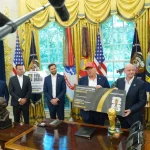
–>
June 29, 2023
During Napoleon’s War of 1812, the Russian officers’ sabers were adorned an inscription, “Do not draw out without need. Do not put it back without glory!”
‘); googletag.cmd.push(function () { googletag.display(‘div-gpt-ad-1609268089992-0’); }); document.write(”); googletag.cmd.push(function() { googletag.pubads().addEventListener(‘slotRenderEnded’, function(event) { if (event.slot.getSlotElementId() == “div-hre-Americanthinker—New-3028”) { googletag.display(“div-hre-Americanthinker—New-3028”); } }); }); }
Whether Putin has drawn out his saber without the need may be debatable, but the geopolitical reality is that he will not put it back without glory, whatever the cost. Putin, who revived Russia, and rebuilt its economy from the ruins of the collapsed Soviet Union, cannot permit his odyssey to end in the country’s dissolution.
On the other side of this Ukrainian confrontation is President Biden, who cannot afford the humiliation of another defeat after the disastrous retreat from Afghanistan. He also needs a victory at any cost.
If history is any guide, weak Russia, with its huge territory and abundant natural resources, will become prey for invaders. In the West, Europeans, driven by compulsion, are eager to retaliate for defeats and loss of territories, some centuries-old, others more recent. Germany, Poland, Hungary, Romania, and Finland have never accepted borders of the post-Second World War period.
‘); googletag.cmd.push(function () { googletag.display(‘div-gpt-ad-1609270365559-0’); }); document.write(”); googletag.cmd.push(function() { googletag.pubads().addEventListener(‘slotRenderEnded’, function(event) { if (event.slot.getSlotElementId() == “div-hre-Americanthinker—New-3035”) { googletag.display(“div-hre-Americanthinker—New-3035”); } }); }); }
Nor is the West the only threat facing Russia. In the East, Japan dreams of the return of the Sakhalin and Kuril islands. And Russia’s “sworn friend,” China, envisages living space for 1.5 billion Chinese and the acquisition of vast natural resources in the Russian Far East.
The imperative of winning puts no limitation on the modus operandi of the war. After 16 months of hostilities, though the war escalates in scope and intensity, NATO and its European allies maintain martial enthusiasm. Driven by the urge for expansion, NATO sees little risk in continuing fighting. Indeed, this time NATO engineered a perfect arrangement. It contracted the Ukrainian army as a mercenary. NATO directs and finances the war, provides strategic and tactical planning, intelligence, and supplies weapons and materiel while the Ukrainians do the fighting. Hence unlike the previous NATO misadventures, thousands of American and other NATO warriors are not coming home in zinc coffins.
America skillfully exploited Ukrainian leaders’ frantic ambition to make Ukraine a member of NATO, ostensibly to protect Ukraine from Russia. The supplicant exhibited a complete lack of judgment, failing to realize that membership in NATO and protection from Russia were mutually exclusive objectives. Consequently Ukraine finds itself in a peculiar situation; membership in NATO is not forthcoming, the country is getting destroyed, and as long as the Ukrainians are dying, the American and European publics are not overly concerned about the war.
At ease with the arrangement, at the recent gathering at G7, the leaders of the so-called advanced democracies committed to supporting Ukraine for as long as it takes. Indeed, prolonging the conflict appears to be a new NATO strategy.
In his famed book, The Art of War, Sun Tzu concluded that “no country benefited from a prolonged war.” This wisdom may not apply to the current conflict. In previous world wars, the winner out-produced the loser. During the Second World War, Americans were losing, on average, six Sherman tanks for every German Tiger tank lost. But at the same time, American industry was manufacturing six Sherman tanks faster than Germans could produce one Tiger. Americans were producing more bombers than Germans were shooting down, which was true for almost every other type of military equipment.
Given that the combined GDP of NATO’s countries exceeds the Russians’ by twenty-fold, Russia cannot win a war of attrition against Europe and the United States in the long run. The folly of this strategy, nevertheless, is that if the economic assumptions prove correct, it will render nuclear confrontation almost inevitable. The recent rhetoric seems to suggest that NATO military planners accept this possibility, believing that Europe is safe under the American nuclear umbrella. Any attack on Europe would invite American nuclear retaliation. Therefore, even if Russians resolve to use a nuclear weapon, they will deploy it on Ukraine.
‘); googletag.cmd.push(function () { googletag.display(‘div-gpt-ad-1609268078422-0’); }); document.write(”); googletag.cmd.push(function() { googletag.pubads().addEventListener(‘slotRenderEnded’, function(event) { if (event.slot.getSlotElementId() == “div-hre-Americanthinker—New-3027”) { googletag.display(“div-hre-Americanthinker—New-3027”); } }); }); } if (publir_show_ads) { document.write(“
There is a lot of wishful thinking in this scenario. First, geography prevents Russians from using nuclear weapons in Ukraine because it is too close to Russia and Belarus to evade radioactive peril.
Second, Western leaders may rely too much on the credibility of the so-called massive retaliation doctrine designed to prevent the invasion of Europe by conventional Soviet forces during the Cold War era. The current scenario is entirely different. The danger is not from the Russian conventional forces but the Russian first-strike nuclear capabilities. The modern weapon is so colossally destructive that given the high density of the European population, one nuclear strike could easily wipe out a hundred million people and turn the continent into a desert. The issue is whether America put itself at risk of monumental destruction on behalf of already devastated Europe. At the heart of the problem is the inherent uncertainty of the nuclear guarantee.
The issue was first raised in January 1967 during a meeting between Henry Kissinger and Konrad Adenauer. Adenauer, then the first Chancellor of the Republic of Germany and a highly regarded politician, asked Kissinger, “Do you think that I still believe you will protect us unconditionally?”
Those who are old enough but do not suffer historical amnesia must remember that in the past, America, despite the rhetoric, abandoned Hungary when the Red Army ravaged Budapest in 1956, abandoned Germany when the Soviets built the Berlin Wall in 1961, and abandoned Czechoslovakia when the Red Army invaded the country in 1968. In all those instances, America stood by helplessly, watching the carnage, all full of bluster and no action.
Although it may sound cynical, America acted in its national interests when it decided that those countries were not worth the risk of nuclear destruction. So, what has changed now? The countries are the same, but the risk is even greater. What makes the Europeans think that the outcome would be different?
This leads us to another relevant issue raised by Adenauer “Are any leaders still able to conduct a genuine long-range policy? Is true leadership still possible today?”
Although the question was raised about 60 years ago, it has acute relevance today. The current crop of Western leaders is not made of the same stuff as Konrad Adenauer, Charles de Gaulle, Richard Nixon, Ronald Reagan, Winston Churchill, Margaret Thatcher, or Donald Trump. They are not visionary; they are not even managerial types. Some of them are simply illiterate when it comes to history and geography. They cannot extrapolate from lessons of the past. Their obsession swept aside the previous safeguards, allowing for a constantly elevating level of conflict without regard for respective national interests and survival. They pushed Europe into the war that was neither necessary nor wise.
No one knows the limits of Russian endurance, but when Moscow starts losing the war, it will be forced to employ nuclear weapons. On the other hand, if Ukraine starts losing the war, some hardheads in Washington are already considering providing Ukraine with nukes as a deterrent. Either way, incompetent leaders are pushing the world toward unparalleled catastrophe.
Alexander G. Markovsky is a senior fellow at the London Center for Policy Research, a conservative think tank that examines national security, energy, risk analysis, and other public policy issues. He is the author of Anatomy of a Bolshevik and Liberal Bolshevism: America Did Not Defeat Communism, She Adopted It. Mr. Markovsky is the owner and CEO of Litwin Management Services, LLC. He can be reached at [email protected]
Photo credit: Geralt Pixabay license
<!–
–>
<!– if(page_width_onload <= 479) { document.write("
“); googletag.cmd.push(function() { googletag.display(‘div-gpt-ad-1345489840937-4’); }); } –> If you experience technical problems, please write to [email protected]
FOLLOW US ON
<!–
–>
<!– _qoptions={ qacct:”p-9bKF-NgTuSFM6″ }; ![]() –> <!—-> <!– var addthis_share = { email_template: “new_template” } –>
–> <!—-> <!– var addthis_share = { email_template: “new_template” } –>





